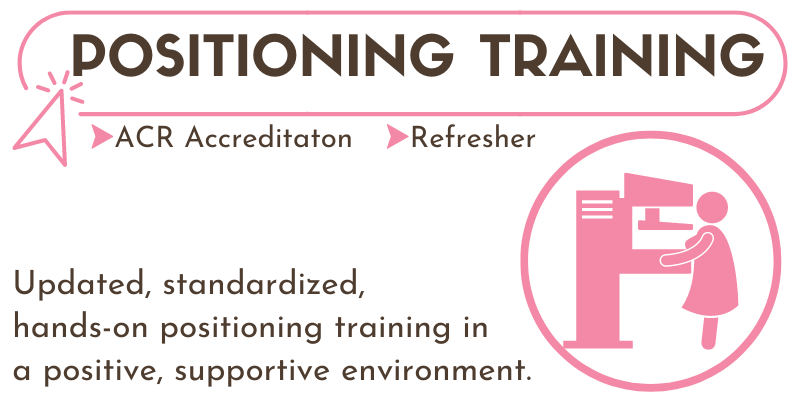Back in the olden days, all patient communication had to go through the patient’s referring physician including biopsy recommendations, ultrasound referrals, additional views and technical repeats, which were almost always related to mammography positioning. At the time, so many of us were new to breast imaging and had no idea what defined "good image quality". Most callbacks were for additional views and technical repeats for positioning were rare as clinical imaging standards had not been clearly identified. For these callbacks, we would contact the referring doctor’s office to let them know the patient needed to return for more images. The office staff would then call the patient to make the arrangements. Fast forward a couple days… the patient is sitting in the waiting room and you call them back for some mag views. You introduce yourself as you are walking to the mammo room when the they say, "I heard that the girl who did my mammogram before (and I think it was you!), messed up my pictures, so I had to come back." She is not happy. You try to backpedal and explain to her that after the doctor, a radiologist, looked at your pictures, he/she requested some additional pictures in order to see things more clearly. The patient’s response, “Well, that’s not what I was told. I heard you all didn’t do a good job.” You then think, Ugh!
Thank goodness times have changed! Now there is direct communication between the breast imaging department and our patients. If the patient needs to be called back, for any reason, hopefully that task falls to someone who has the special skills needed to do so because many patients become extremely anxious when they are called back, even if it is for motion. They often jump to the conclusion that there is a cancer the size of the state of Texas growing inside their breast. They think we are lying to them and are just trying to keep their horrible fate a secret.
By the way... this is actually quite a normal response, even for those of us who are radiographers/mammographers. We don’t just get bad headaches... we assume we have a brain tumor. We don’t just get a callback on our mammogram for micro-calcifications... we are deciding if we want a lumpectomy or mastectomy. This is called catastrophizing and it's human nature for most of us. I, for one, am really good at it! My daughter was never late coming home from a high school dance; she was lying severely injured on the roadside calling my name. Yeah, I know, but I am sure you do it too at times.

When I perform a patient’s baseline mammogram, which I love to do so I can dispel all the ugly myths they've possibly heard before they come in, I always say to the patient before they leave, "Since this is your first mammogram and we have no previous images to compare them to, many times patients are called back for extra images and/or an ultrasound. This is a very normal process and I wanted to let you know, in case they do give you a call." If you happen to see an area of concern while doing a screening mammogram, I just eliminate the part about their first mammogram and instead say, "As a reminder, many times patients get called back for additional pictures and/or an ultrasound. This is a normal process! What mammograms are really good at, is seeing changes in your breasts. Which is why we want to do them every year and compare them to your previous mammograms. I can assure you that the vast majority of changes turn out to be nothing, but we want to make sure if there are changes, that those changes are normal for YOU.”

- Do not call on a Friday afternoon.
- Do not call the patient's work number, unless absolutely necessary.
- Be prepared to offer an appointment because the patient will want to get in ASAP.
- Use terminology the patient will understand, such as “extra pictures/images”, NOT "MLO/mag views", etc.
- If you have to leave a message, simply say, “Hi, this is Suzy from ABC Breast Center. Can you please give me a call back at 123-456-7890. If I am on another line, please leave a message and I will call you back. Thanks!”
- Remain upbeat! Remember, most of the time things are fine. However, don’t ever say, “I am sure everything will be fine," as this might not be true and that phrase will provide false reassurance.
- I never say the word "cancer" to the patient, unless of course we are talking about a previous diagnosis or family history. I use the word "changes" when referring to what we look for and see on a mammogram. I also explain that most changes (almost 90%) are normal, but we need to be sure it is normal for them, by taking extra pictures, having an ultrasound, having a biopsy, etc.
- Acknowledge their anxiety using broad terminology, by saying "most patients” rather than saying “you”. For example, "Most patients are anxious when they are called back, but I can assure you that this is quite common.”
- If pressed for more information, reiterate that you (or the person calling) are not the radiologist, whose expertise is to interpret the images, and that the doctor simply needs more information in order to make the proper recommendations. Let the patient know how and when they will receive their report. For example, "The radiologist will be looking at your images while you are here and you will know the results before you leave.”... or... “You will receive the results from your doctor. They will have the report within three days, so you might want to check in with them.” (It is obviously preferred for the patient to get their results at the time of the additional imaging/ultrasound.)
- Invite questions: "Do you have any questions for me?”

Many times, after telling a patient they need to come back, they instantly respond by asking, “Why, what’s wrong?!” ... or ... "What did they see??” ... or ... “You can tell me. I won’t tell!” (Even though they often do tell!) While mammography technologists and trained office staff can effectively make these phone calls, it is important to remember to remain calm, and as patients may press for more specific information, use scripts.
Hi, this is Suzy from ABC breast center. How are you today? I am calling you to let you know that the radiologist, the doctor who looked at your mammogram, would like you to come back for some extra pictures. What mammograms are really good at is seeing changes in your breasts. I can assure you that the vast majority of changes turn out to be nothing, but we want to make sure if there are changes, that those changes are normal for YOU. I have an appointment available at ___ on___ will that work for you?

Technical callbacks (TCB) are a little trickier, especially for inadequate image quality. As a reference, the TCB rate should be less than 5% with most facilities averaging less than 3%. So if your TCB rate is high, this should be a sign that a tech or techs may need some help with positioning. This is one of the purposes of collecting this data and compliance with EQUIP. Most TCBs in the "digital era" are due to motion and this is tricky, as many times the technologist cannot detect motion on her work monitor. Remember that you should not take a TCB for motion personally. It is not a failure on your part and in truth, as you have explained to the patient, you cannot see it on your workstation monitor.

- If the patient is somewhat unstable, have them sit down. This will help decrease motion and increase patient safety.
- Watch for breathing patterns. Many times you can see the patient move or breath while the exposure is being made, so it's best to scan the image for motion while you have the mention present.
- Use a breathing technique, whatever you find works best for you. The important thing is to wait to tell them to hold their breath (if this is technique you want to use), until you "rotor up".
- Motion related to cardiac rhythms can best be seen in the LLIQ. You may want do a quick look at this specific area before releasing the patient if you suspect motion.

If you are calling a patient back for motion, remember stay calm, refer to your script and offer the patience reassurance.
Hi, Mrs. Smith, this is Margie from ABC breast center. How are you today? I am calling to ask you to come back so we can repeat one (or more) of your pictures, as the radiologist noticed some blurring on it/them. It is very difficult for the technologist to see this when they are checking your mammogram before you leave. I can assure you this is very normal and we will get you right in and out, as well as have the radiologist check the images before you leave. I have an appointment available at ___ on___ will that work for you?

Since the early days of mammography that I described above, with new technology and strict clinical image guidelines regarding image quality, callbacks have been greatly reduced. But, we need to continue to do our best to reduce the anxiety that callbacks can mean for those of us who perform them, and and most of all for our patients who receive the callback.
Regardless of who does the important, necessary and often challenging task of calling back a patient, they must be prepared to respond to patient questions. The best way to plan for this is by creating scripts that use easy-to-understand terminology, which will acknowledge the patient’s anxiety and provide them with reassurance. Proactivity is essential! Here are some common patient questions you may encounter:

Changes can occur in the breast from year to year and they can appear in many different ways. Sometimes it is just an overlap of tissues. I can assure you that most changes in the breast are normal, but we need additional images to make sure this is normal for YOU.

The radiologist who reviewed the images saw a change and again, we cannot be sure that is normal for you without additional pictures/an ultrasound.

I'm sorry, I cannot. I am not a radiologist. They are the experts who read the mammograms.

I know it’s hard not to worry, but we do need to get more information before the radiologist can issue a report.

The majority of changes in the breast turn out to be normal. We can only tell if something seen on a mammogram is a cancer with further testing. So there is no way of knowing at this point.
Hopefully this blog has answered some of your questions about how to handle these very important and often challenging patient conversations. Callbacks are never fun, but they don't have to be difficult if you stick to your scripts! We wish you the best of luck and invite you to check out our many resources available HERE.



